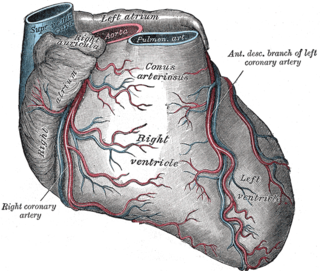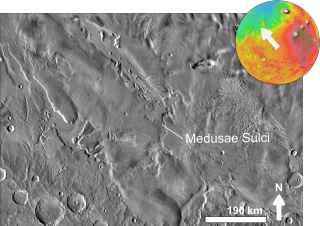
In neuroanatomy, the central sulcus is a sulcus, or groove, in the cerebral cortex in the brains of vertebrates. It is sometimes confused with the longitudinal fissure.

In neuroanatomy, the lateral sulcus is one of the most prominent features of the human brain. The lateral sulcus is a deep fissure in each hemisphere that separates the frontal and parietal lobes from the temporal lobe. The insular cortex lies deep within the lateral sulcus.

The postcentral sulcus of the parietal lobe lies parallel to, and behind, the central sulcus in the human brain.

In neuroanatomy, a gyrus is a ridge on the cerebral cortex. It is generally surrounded by one or more sulci. Gyri and sulci create the folded appearance of the brain in humans and other mammals.

In biological morphology and anatomy, a sulcus is a furrow or fissure. It may be a groove, natural division, deep furrow, elongated cleft, or tear in the surface of a limb or an organ, most notably on the surface of the brain, but also in the lungs, certain muscles, as well as in bones, and elsewhere. Many sulci are the product of a surface fold or junction, such as in the gums, where they fold around the neck of the tooth.
The term Lacrimal or lachrymal, may refer to:
Terminal sulcus or Sulcus terminalis may refer to:

In neuroanatomy, a sulcus is a depression or groove in the cerebral cortex. It surrounds a gyrus, creating the characteristic folded appearance of the brain in humans and other mammals. The larger sulci are usually called fissures.

The coronary sulcus is a groove on the surface of the heart at the base of right auricle that separates the atria from the ventricles. The structure contains the trunks of the nutrient vessels of the heart, and is deficient in front, where it is crossed by the root of the pulmonary trunk. On the posterior surface of the heart, the coronary sulcus contains the coronary sinus. The right coronary artery, circumflex branch of left coronary artery, and small cardiac vein all travel along parts of the coronary sulcus.

The olfactory tract is a bilateral bundle of afferent nerve fibers from the mitral and tufted cells of the olfactory bulb that connects to several target regions in the brain, including the piriform cortex, amygdala, and entorhinal cortex. It is a narrow white band, triangular on coronal section, the apex being directed upward.
Interventricular groove may refer to:
Interventricular sulcus may refer to:

In neuroanatomy, the marginal sulcus is a sulcus (crevice) that may be considered the termination of the cingulate sulcus. It separates the paracentral lobule anteriorly and the precuneus posteriorly.
A fissure is a narrow crack or opening in the Earth's surface
Also known as the Malleolar groove.
The superior sulcus (groove) may refer to:

Sulcus is, in astrogeology, an area of complex parallel or subparallel ridges and furrows on a planet or moon.

In neuroanatomy, the subparietal sulcus or suprasplenial sulcus is a sulcus, or crevice, on the medial surface of each cerebral hemisphere, above the splenium of the corpus callosum. It separates the precuneus from the posterior part of the cingulate gyrus. It is the posterior continuation of the cingulate sulcus. The cingulate sulcus actually "terminates" as the marginal sulcus of the cingulate sulcus. It extends posteriorly toward the calcarine sulcus.
Blestia is a monotypic genus of North American dwarf spiders containing the single species, Blestia sarcocuon. It was first described by Alfred Frank Millidge in 1993, and has only been found in United States.

The occipital gyri (OcG) are three gyri in parallel, along the lateral portion of the occipital lobe, also referred to as a composite structure in the brain. The gyri are the superior occipital gyrus, the middle occipital gyrus, and the inferior occipital gyrus, and these are also known as the occipital face area. The superior and inferior occipital sulci separates the three occipital gyri.
This page is based on this
Wikipedia article Text is available under the
CC BY-SA 4.0 license; additional terms may apply.
Images, videos and audio are available under their respective licenses.









